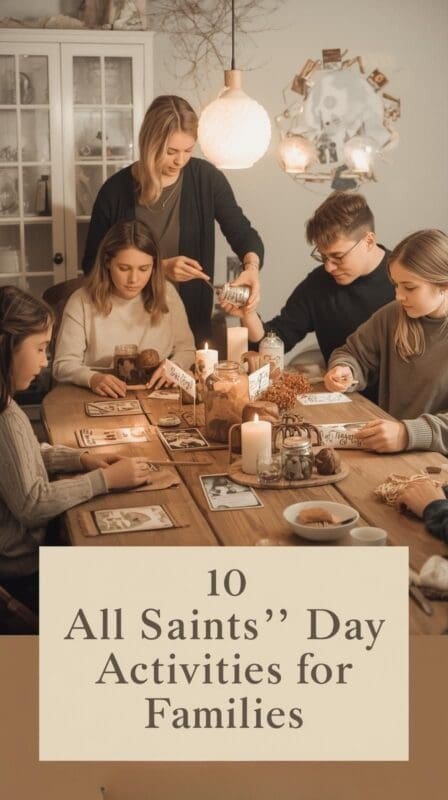Children grieve differently than adults—they draw, build, plant, and light candles to say what words can’t. All Saints’ Day can become a gentle space for those unspoken feelings to take shape.
It’s important to disclose that this blog post contains affiliate links. This means that if you make a purchase through these links, we may earn a commission at no additional cost to you.
A Story That Starts with Light
One autumn afternoon, a six-year-old client walked into my therapy room holding a paper heart.
“It’s for Grandma,” she whispered, setting it on our little Memory Tree.
We glued it to a branch, and for a moment she smiled through tears.
That moment—simple, creative, sacred—is what All Saints’ Day can be for children: not about death, but about love that still belongs to them. When children are given safe rituals and kind structure, their nervous systems find calm and their hearts learn that memory and healing can coexist.
This guide offers counselor-informed, trauma-sensitive All Saints’ Day activities for kids—gentle crafts, stories, and rituals that help families and classrooms honor loved ones while nurturing emotional regulation and hope.
🧠 How Kids Understand Loss
Grief isn’t one size fits all. How a child processes death depends on developmental stage:
- Ages 3–6 often think magically. They may believe someone “comes back” or wonder, “Did I cause it?” They need reassurance and repetition.
- Ages 7–10 begin grasping permanence but may hide sadness to protect others. Routine and honesty help restore safety.
- Older children blend logic with emotion. They may need privacy or creative outlets more than direct conversation.
Counselor note: Children’s grief ebbs and returns. A laugh doesn’t mean they’ve “moved on”; a tear months later doesn’t mean they’re stuck.
The goal isn’t to erase sadness—it’s to make it less lonely.
🕯 Why Rituals Help Children Heal
Rituals are anchors in emotional storms. They calm the nervous system through predictable, sensory steps—lighting, touching, arranging, repeating.
Occupational and grief therapists call this embodied regulation: when hands move, feelings move too.
- Lighting candles signals safety through soft light.
- Decorating or planting externalizes feelings safely.
- Repetition (annual traditions) builds continuing bonds—the understanding that love outlives loss.
When children create something tangible, they give shape to emotions too big for words. Each activity below turns remembrance into rituals of regulation.
🌸 Ten All Saints’ Day Activities for Kids
Each “therapy card” includes a sensory picture, emotional rationale, and gentle guidance.
1. Light a Candle Together
Picture This:
A dim autumn room; a family gathered around a single warm glow. Silence, then one memory shared—soft laughter in the stillness.
Why It Helps:
Predictable rituals lower cortisol and cue safety. Light soothes the vagus nerve and provides visual focus for young children.
How to Try It:
Use one flameless or battery candle for each person honored. Share one memory or “thank you” before lighting.
Counselor Tip:
Let the child decide who they’d like to remember; choice builds agency.
Safety Note:
Avoid open flames in therapy spaces or with younger kids.
2. Create a Memory Box
Picture This:
Colored paper, stickers, ribbon. Tiny hands glue stars on a box labeled “Grandpa’s Stories.”
Why It Helps:
A container provides symbolic structure—children can hold memory safely outside their body.
How to Try It:
Decorate a small box. Add photos, drawings, or symbolic items.
Invite the child to “visit” it when they miss their person.
Counselor Tip:
Include sensory items—fabric that smells familiar, a pebble from their garden.
Safety Note:
Use paper or wood boxes (no glass).
3. Draw the “Saints of My Life”
Picture This:
Crayons spread across the table. A child sketches their teacher, mom, and neighbor, labeling each “My Saints.”
Why It Helps:
Expands grief into gratitude. Encourages seeing positive models and community care.
How to Try It:
Draw people who help you feel loved or inspired. Add small captions like “She helps me feel safe.”
Counselor Tip:
This works beautifully in classrooms—connects social-emotional learning with compassion.
Safety Note:
Keep drawings inclusive; let kids define “saint” or “helper” in their own words.
4. Gratitude Leaf Collage
Picture This:
Paper leaves in gold and russet taped to a tree outline. Each one carries words like “Her cookies” or “His hugs.”
Why It Helps:
Combines creative movement with cognitive reframing—turning loss into thankfulness.
How to Try It:
Cut paper leaves; write one grateful memory per leaf. Arrange on wall or branch.
Counselor Tip:
Ask: “What leaf do you want to add today?”—a simple daily check-in.
Safety Note:
Display in public classroom or office corner to model shared remembrance.
5. Share Stories at Dinner
Picture This:
Candlelight over soup bowls. Someone laughs remembering Grandpa’s silly dance. Tears and smiles mingle easily.
Why It Helps:
Narrative sharing integrates memory across both brain hemispheres. Storytelling restores connection.
How to Try It:
Set one meal for remembering. Each person tells a story—funny, touching, small.
Counselor Tip:
Use a “talking spoon” for turn-taking in groups of kids.
Safety Note:
Normalize laughter—it doesn’t disrespect grief; it releases it.
6. Visit a Peaceful Place
Picture This:
An autumn walk through a park; leaves crunching; a small bouquet laid under a favorite tree.
Why It Helps:
Movement regulates the body; nature provides external calm for internal storms.
How to Try It:
Visit a garden, beach, or cemetery; notice colors, sounds, textures. Say a quiet thank-you aloud.
Counselor Tip:
Have children collect a small nature token—a pinecone, petal, or stone—as a grounding object.
Safety Note:
Keep outings brief for younger children; emotional fatigue can set in quickly.
7. Prayer or Affirmation Circle
Picture This:
A ring of children seated on soft floor cushions; gentle instrumental music; hands clasped or resting quietly.
Why It Helps:
Group rhythm regulates heartbeat and builds collective safety. Words of love or blessing anchor emotion.
How to Try It:
Faith-based: share a short prayer. Secular: repeat affirmations like “We are loved; we remember with joy.”
Counselor Tip:
Include “quiet listening moments”—teaches tolerance of silence.
Safety Note:
Avoid pressuring participation; presence alone heals.
8. All Saints’ Day Scrapbook
Picture This:
A binder filled with drawings, photos, and kind words—pages of color and comfort.
Why It Helps:
Transforms grief into creative storytelling; engages both art and narrative expression.
How to Try It:
Add one new page each year—a living document of love.
Counselor Tip:
Encourage mixed textures: fabric, lace, paper—multi-sensory for regulation.
Safety Note:
Store privately; share only if the child chooses.
9. Plant a “Memory Flower”
Picture This:
Little fingers pressing soil around a daffodil bulb. A tag reads, “For Nana.” Spring will bring color again.
Why It Helps:
Symbolizes growth and renewal. Watching it bloom builds hope.
How to Try It:
Plant a bulb or seed in a pot or garden. Talk about cycles—how things rest, then grow again.
Counselor Tip:
Integrate seasonal follow-ups: photograph its growth; reflect on emotional change.
Safety Note:
Avoid toxic plants; supervise soil handling.
10. End the Day with Gratitude
Picture This:
A child tucked in bed whispers, “Thank you for reading with me, Grandpa.” A night-light glows softly.
Why It Helps:
Ending on gratitude lowers arousal levels and fosters emotional security before sleep.
How to Try It:
Each night, name one thankful thought about the person remembered.
Counselor Tip:
Create a “Gratitude Jar” to hold written notes—review them on anniversaries.
Safety Note:
Keep bedtime calm; avoid intense discussion right before sleep.
💬 Conversation Starters for Grief
When words are hard, gentle questions guide connection:
- “What do you miss most about them?”
- “What’s something funny they used to do?”
- “If they could see you today, what would make them proud?”
- “Would you like to draw or talk about them today?”
Counselor guidance:
Silence can also be healing. Sitting beside a child in shared quiet says, You don’t have to carry this alone.
🧩 Counselor’s Corner: Turning Grief into Growth
| Emotional Skill | Supporting Activity | What It Builds |
|---|---|---|
| Gratitude | Gratitude Leaf Collage | Focus on love that remains |
| Emotional Expression | Memory Box, Scrapbook | Safe externalization of feelings |
| Empathy | “Saints of My Life” Drawings | Awareness of positive role models |
| Self-Regulation | Candle Lighting, Nature Walk | Calms nervous system through sensory ritual |
| Hope | Memory Flower | Visual reminder that life renews |
Reflection:
Rituals transform grief into gratitude. Each creative act says, “Love still lives here.”
❓ FAQs
Is it okay if my child doesn’t want to talk?
Yes. Offer choice. Drawing, walking, or lighting a candle in silence still expresses grief.
How can teachers or counselors support a grieving student?
Maintain routine; predictability equals safety. Offer creative outlets without forcing sharing.
What books help kids understand loss?
- The Invisible String by Patrice Karst
- The Memory Box by Joanna Rowland
- When Dinosaurs Die by Laurie Krasny Brown
Should I use religious or secular language?
Use what aligns with your family or classroom. The key is reassurance: They are remembered, and you are safe.
Can these be used in therapy or classrooms?
Absolutely. Choose scent-free candles, trauma-sensitive language, and inclusive imagery.
🌼 Reflective Conclusion
All Saints’ Day reminds us that memory isn’t the opposite of healing—it’s part of it.
When children light, draw, plant, or create, they practice emotional regulation disguised as love.
Grief changes shape, not truth. Love remains.
Let these small rituals become an annual rhythm—a gentle tradition of remembrance, gratitude, and growth.

About the Author
Hi, I’m Eve, a former school counselor with a master’s degree in School Psychology and a passionate advocate for children and families navigating sensory challenges. As a mom of children with sensory sensitivities, I deeply understand the journey special-needs parents face, and I dedicate myself to researching and sharing practical solutions to help children thrive and feel comfortable in their bodies. My goal is also to empower counselors, therapists, and psychologists with creative strategies and supportive resources to enrich their everyday practice. When I’m not writing or exploring new therapeutic approaches, you’ll find me spending quality time with my family and continually seeking inspiration from everyday moments.



